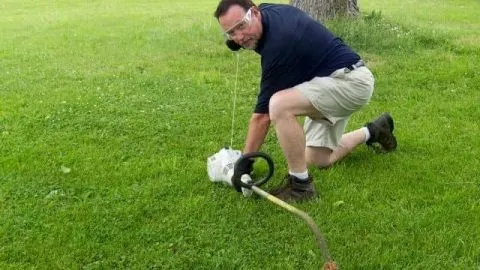So, your two-stroke engine starts out pretty well but just as it gets to full throttle, it cuts out. So frustrating, right?
These are the common causes for a two-stroke engine dying at full throttle:
- Carburetor
- Air Filter
- Fuel Filter
- Fuel Pump
- Spark Plug
- Gaskets
A good assessment of these different parts of your engine can help you find the culprit and replace it or fix its problem.
In this article, we’ll go through different engine parts and the issues that can result in your engine stalling at full throttle. We’ll also point out how to fix the different problems. Let’s begin.
Carburetor
Carburetors mix air and fuel at a precise ratio for the combustion process. Anything that prevents the proper airflow or entry of fuel will result in the inefficiency of the carburetor. This can lead to the symptom of your two-stroke engine dying at full throttle.
There are a few common problems that can be encountered with a carb. Let’s have a look at some of them and their solutions.
Clogged Carburetor
This is one of the most common causes of a malfunctioning carburetor. If old fuel stays for a long time in the system, say over winter, it will eventually clog the carb and prevent it from functioning properly. Dirt accumulation in the carb can also cause obstruction.
To know if the problem is clogging, lift the covers to the carburetor and remove the air cleaner cap and filter. Carefully check for any obstructions.
Clogging in the carburetor will result in an air/fuel imbalance leading to either too much air for the amount of fuel or inadequate fuel for the amount of air, a situation referred to as a lean condition (source).
Solution: The only solution to dirt accumulation is cleaning up of the carburetor. A carburetor cleaner will do the job.
One easy way to do this is running the engine and revving it up while spraying the inside with the cleaner. If this isn’t sufficient, you may need to disassemble the whole carburetor and do a thorough cleanup.
Damage or Corroded Carb
This is another problem to look out for, especially if your engine is old or has been used very frequently. Normal wear and tear can result in damage to the carburetor.
Be on the lookout for any impairments while you disassemble the carburetor, preferably using a carb kit. Are the throttle shafts worn out hence leaking air? Is the carburetor housing damaged or warped? Is the internal surface corroded? Are there any missing or weak springs?
Solution: If only a few parts of the carb are damaged, e.g., the springs, you can replace just those parts. But if the carburetor itself is damaged, you will have to replace the whole thing and rebuild it.
Poorly Adjusted Carburetor
If the adjustment screws in the carb are not optimally set, you may end up with an air/fuel mixture that’s either too lean or too rich.
Solution: Identify the adjustment screws and adjust the carburetor until the air/fuel ratio is well balanced.
Here’s a short video to help you better understand how a carburetor works and give you the basics of adjusting the mixture screws:
Air Filters
The purpose of air filters is to filter the air that gets into the engine. Filters prevent dirt, debris, and any particles from getting into the engine.
Obstructed Airflow
Over time, dirt and debris build up in the air filters. This causes clogging, which prevents sufficient amounts of oxygen from reaching the engine.
Engine stalling occurs when the air filters are partially clogged, meaning just a little oxygen gets into the engine to allow for idling but not sufficient enough to sustain a full throttle.
Solution: Regularly replacing air filters will prevent dirt build-up and eventual clogging. So how do you do this? On top of the carburetor, locate the air filter cover. Remove the screws or tabs that secure it in place and lift off the cover. Remove the old filter and replace it with a new one.
Fuel Filters
Just like the name suggests, fuel filters are used to sieve out dirt from fuel and prevent the particles or debris from getting into the carburetor and engine.
Some engines have an internal fuel filter, i.e., located inside the fuel tank while other engine’s fuel filters are located along the fuel line just before the carburetor.
Clogged Fuel Filter
Dirt particles accumulated in the fuel filter can cause clogging. This is one of the causes of engine stalling since the amount of fuel getting to the engine is only sufficient to run the engine on idle but cannot sustain a full throttle.
Solution: Inspect the fuel filter for any obstruction. First, remove the filter and blow through it. In case of any blockage, you can clean out the filter or replace it with a new one.
To avoid any problems in the future, you should make replacement of the fuel filter part of the regular maintenance.
Fuel Pumps
The function of a fuel pump is to pump fuel from the tank to the carburetor.
Malfunctioning Fuel Pumps
Fuel pumps work on vacuum pressure which is delivered to the pump through the vacuum line. If the vacuum line is cracked or damaged in a way that allows air into the system, it will cause the pump to malfunction.
A malfunctioning fuel pump will cause inadequate fuel from reaching the engine, which results in the engine dying.
Solution: Any damaged vacuum line should be replaced immediately.
Weak Fuel Pump
After inspecting the engine, if you find that the vacuum line is okay or you have just replaced it, and the engine is still stalling, then it means the problem is with the pump. A weak or worn out pump cannot push enough fuel to the engine.
Solution: Replace the worn-out fuel pump with a new, properly functioning one.
Spark Plugs
Spark plugs work in the combustion chamber to ignite the air and fuel mixture.
Damaged Spark Plugs
Spark plugs that are worn out, broken, melted, corroded, or covered in deposits can fail and cause the engine to stall at full throttle.
Solution: Assess the state of the spark plug. Remove it and check for any of the above symptoms. In case of any oily build-up, clean the spark plug and check for defects.
The spark plug is normally brown or light grey in color, if it’s not, then replace it. If it is damaged in any way, replace it.
As part of the regular maintenance, spark plugs should be replaced at least once per year.
Gaskets
These are seals that prevent entry or exit of air or fluid into places where they do not belong.
Leakage Through Gasket
A damaged gasket below the carburetor will cause leakage of air into the engine resulting in excess air. This can result in a lean condition and cause rough idling and engine dying at full throttle.
Solution: Remove the gasket to inspect for damages or leaks. Since gaskets are one-time use, you will need to replace it once you remove it from below the carb (regardless of its condition).
Conclusion
As you can see, there are many things that can cause your two-stroke engine to die at full throttle.
The carburetor is always deemed as the first culprit, but if the stalling persists after adjusting, cleaning, or replacing the carb, then the cause of the problem is likely:
- A clogged air filter
- Obstructed fuel filter
- Weak fuel pump
- Leaking at the gasket
- Damaged spark plugs
All of these issues can be corrected by carefully assessing the different parts and doing a thorough clean up or replacement as is necessary.
Sources
- E Replacement Parts: Engine: Engine Will Idle But Dies At Full Throttle
- E Replacement Parts: Trimmer: Engine Will Idle But Dies At Full Throttle
- E Replacement Parts: Chain Saw: Engine Will Idle But Dies At Full Throttle
- Mechanics- Stack Exchange: Two-stroke engine dies at full throttle
- Mechanics- Stack Exchange: Two-stroke engine seizing at full throttle

